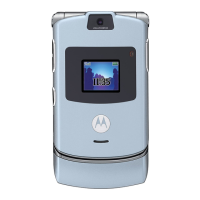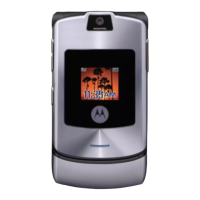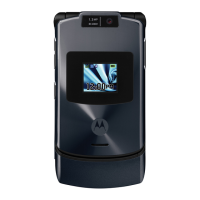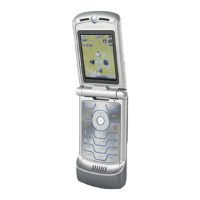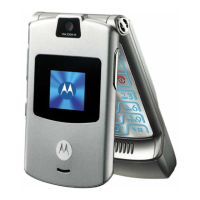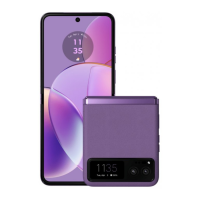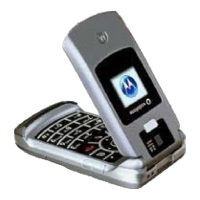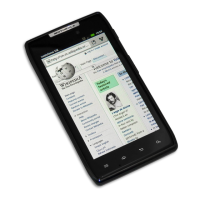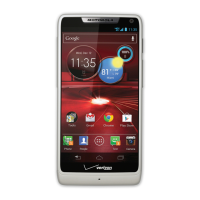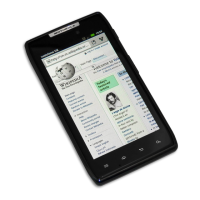
Do you have a question about the Motorola RAZR V3m and is the answer not in the manual?
| Network Technology | CDMA / EVDO |
|---|---|
| Status | Discontinued |
| Dimensions | 98 x 53 x 13.9 mm (3.86 x 2.09 x 0.55 in) |
| SIM | Mini-SIM |
| Display Type | TFT, 256K colors |
| Card Slot | No |
| Alert types | Vibration; Downloadable polyphonic, MP3 ringtones |
| Loudspeaker | Yes |
| 3.5mm jack | No |
| Messaging | SMS, MMS, Email |
| Browser | WAP 2.0/xHTML |
| Radio | No |
| Games | Yes + downloadable |
| Java | Yes, MIDP 2.0 |
| Stand-by | Up to 200 h |
| Talk time | Up to 3 h |
| Call records | Yes |
| Announced | 2006 |
| Display Size | 2.2 inches |
| Display Resolution | 240 x 320 pixels |
| Second external display | 65K colors, 96 x 80 pixels |
| Bluetooth | v1.2 |
| Colors | Silver |
| Phonebook | 1000 entries |
| Network | CDMA 800 / 1900 EVDO |
Overview of main menu options like GET IT NOW and RECENT CALLS.
Lists available tools such as Calendar, Alarm Clock, Notepad, and Calculator.
Options for sound settings, including Ring Styles and Talking Phone Settings.
Configuration options for the phone's system, including System Select and Device Info.
Settings related to call management, such as In-Call Setup and Headset options.
Settings for phone connections, including Incoming Call and Bluetooth.
Guidance on keeping the phone safe from liquids and dust to ensure proper function.
Reminder to read important safety and legal information before first use.
Factors influencing battery life, including network, signal strength, and temperature.
Instructions on avoiding extreme temperatures and proper battery handling.
Step-by-step instructions for installing the phone's battery.
Procedure for charging the phone using the provided charger.
Instructions on how to power on the Motorola RAZR V3m wireless phone.
Steps to initiate a phone call and end an active call.
Information on how to adjust the phone's volume levels.
How to adjust call alert styles when the phone flip is open.
Guidance on accessing the 'Get It Now' feature for content downloads.
Instructions for downloading music and selecting storage locations.
Steps to organize and create custom music playlists.
How to add songs to an existing playlist.
Instructions for reordering songs and removing them from playlists.
How to play songs and access options like Shuffle and Get V CAST Music.
Guide on how to quickly create voice recordings using the voice key.
Instructions on how to play, rename, and manage voice records.
Steps to access the Pix & Flix menu for photo and video.
Options for customizing video camera settings like brightness.
Instructions on how to play video clips stored on the phone.
Guide on activating the camera and taking photos.
Options for customizing camera settings like resolution and shutter sound.
Customization options for multimedia messages, like shutter sound and color effects.
How to add contacts or recent calls to a message.
Viewing message contents and using prewritten Quick Text messages.
Instructions for inserting a microSD memory card into the phone.
How to access and interpret memory card storage information.
List of file types (PIX, Sounds, etc.) compatible with the memory card.
List of file types (FLIX, Music, Voice Record) compatible with phone memory.
Information on Bluetooth compatibility and vehicle connectivity.
Steps to pair the phone with headsets, handsfree devices, or PCs.
Instructions for connecting the phone to a PC using a USB cable.
Guide to navigating the phone's home screen and main menu.
Explanation of the signal strength indicator bars.
Indicator for data call, tethered mode, or WAP/BREW applications.
Indicators for Location status and Keypad Lock status.
Indicators for speakerphone activation and missed calls.
How to use the navigation key for menu interaction.
Explanation of icons representing features in the main menu.
Guide to using the message center to compose and send text messages.
Description of different text entry modes like iTAP English.
How to cycle through capitalization and number input methods.
A chart guiding character entry using Tap mode.
Notes on capitalization and entering text, including word completion.
Using word completion to speed up text entry.
How to enter symbol characters from a text entry screen.
Instructions on how to turn on the integrated handsfree speakerphone.
Configuring the speakerphone to automatically turn off after inactivity.
Explanation of Airplane mode and its limitations on calling features.
Procedure for changing the phone's unlock code, PIN, or password.
How to lock and unlock the phone's keypad to prevent accidental presses.
Information on default security codes and what to do if forgotten.
Selecting and customizing ringer and alert styles for different events.
Adjusting specific ringer or vibration patterns for calls, alerts, and reminders.
Steps to download new ringtones through the 'Get It Now' service.
Using multi-key or open-to-answer methods for incoming calls.
How to choose a picture to be displayed as the screen saver.
Configuring the time delay before the screen saver activates.
Tips to improve AGPS performance by avoiding interference.
How the ambient light sensor extends battery life by adjusting backlight.
Explanation of the automatic redial function for busy signals.
Instructions for making emergency calls, including using AGPS.
How AGPS assists emergency services by providing location data.
How the phone stores and sorts lists of received and dialed calls.
How to view and return missed calls.
Assigning unique speed dial numbers to contacts.
Instructions on how to listen to voicemail messages.
Accessing options like Contacts, Bluetooth, and TTY Mode during a call.
Overview of messaging capabilities, including multimedia messages.
Saving pictures or sounds from multimedia messages.
Viewing and editing messages saved in the Drafts folder.
Steps for adding a new contact to the phone's address book.
How to assign contacts to specific groups.
Instructions for creating new groups within the contacts.
How to call a number stored in the contacts list.
Assigning speed dial numbers to contacts for quick dialing.
Setting distinctive ringtones for individual contacts.
Creating custom ringtones by recording audio.
Steps to download ringtones via the TUNES & TONES menu.
Introduction to using voice commands for phone operations.
Using voice commands to send multimedia messages with pictures.
Using voice commands to check phone status like signal strength.
Modifying settings related to voice command recognition and performance.
Adjusting call volumes and key press sounds.
Setting the colors and styles for the phone's display screens.
Options to customize the visibility of menu icons on the home screen.
Creating a custom heading to display on the phone's home screen.
Enabling DTMF tones for dialing.
Checking data usage statistics like transmitted and received kilobytes.
Allowing other Bluetooth devices to discover your phone.
Switching to a headset or car kit during an active call.
Accessing and adjusting network settings.
Configuring alerts for network call drops.
Adding events and appointments to the phone's calendar.
Instructions for setting and disabling alarms.
Accessing and using the built-in calculator function.
Procedure for changing unlock codes and security passwords.
Steps to download games and applications via 'Get It Now'.
How to view and play video clips stored on the phone.
Information on how to get help and support from Motorola.
Confirmation that the phone meets government requirements for radio wave exposure.
Details on the highest SAR values measured for the phone at the ear and body.
Important information on the safe and efficient use of the mobile device.
Adherence to local regulatory requirements during phone use.
Information regarding RF energy exposure and approved accessories.
Instructions to turn off the device in sensitive locations to avoid interference.
Precautions to minimize interference, such as avoiding breast pockets.
Advice for using the mobile device safely while driving.
Advisories for using devices in public areas and regarding automobile air bags.
Guidance on what to do with damaged phones or batteries.
Safety advice regarding potential breakage of glass parts on the device.
Details on the scope and limitations of the Motorola Limited Warranty.
Specific warranty terms for decorative accessories and cases.
Warranty coverage for products and accessories that have been repaired or replaced.
Conditions and actions that are excluded from warranty coverage.
Explanation of warranty terms for software not embodied in physical media.
Contact information for warranty service related to accessories and software.
How Motorola phones are rated for compatibility with hearing aids.
Information from WHO regarding RF exposure and potential precautions.
Information on export regulations for the product in the US and Canada.
Checking local laws and regulations for mobile device use while driving.
Recommendations for using handsfree devices to maintain focus on the road.
Avoiding distractions like taking notes or looking up numbers while driving.
How to use the mobile device to assist in emergencies.
